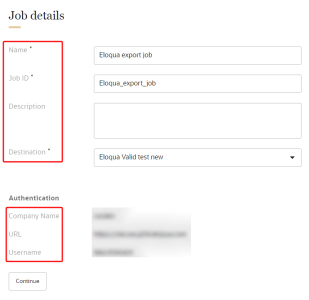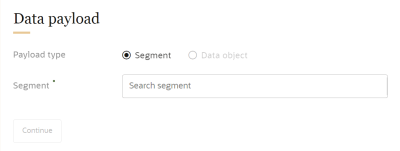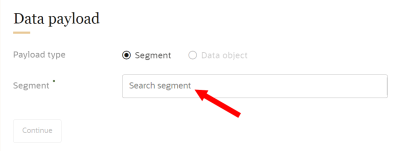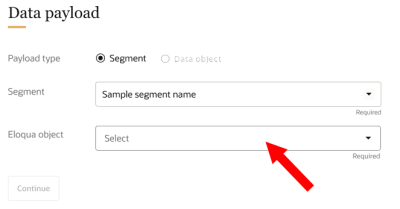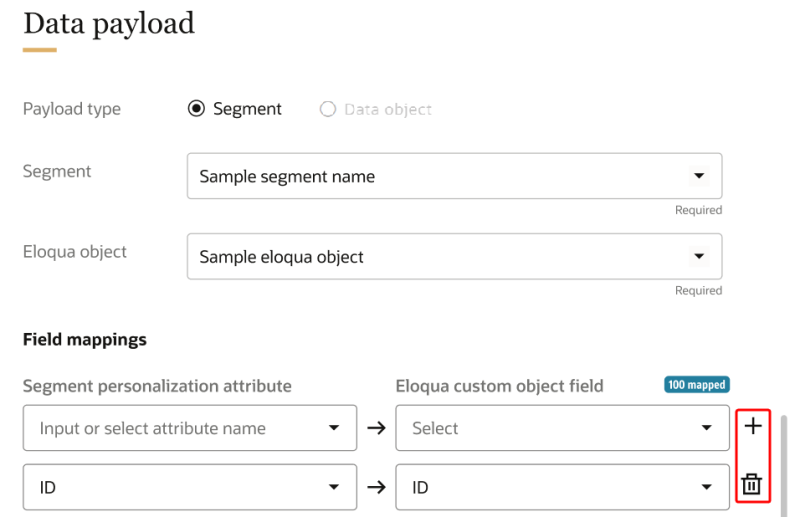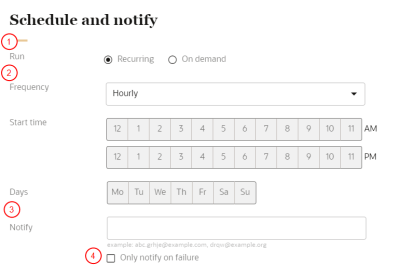Exporting Oracle Unity segments into Oracle Eloqua custom objects
Exporting Oracle Unity segments into Oracle Eloqua custom objects requires the following tasks:
- Create an Eloqua destination
- Create an Eloqua export job
- After setting up the export of data, learn more about Custom objects from the Oracle Eloqua Help Center.
Create an Eloqua destination
You will first need to follow the steps for Creating an Oracle Eloqua destination.
Create an Eloqua export job
To create an Eloqua export job:
-
Click the Oracle icon
 in the bottom-right corner to open the navigation menu.
in the bottom-right corner to open the navigation menu.
- Select Data feeds.
- In the top-right corner, click Create data feed, then select Export job.
The Create export job page is displayed.
Note: You can open and close the different sections on the page by clicking the Arrow button ![]() , or anywhere else in the section heading.
, or anywhere else in the section heading.
Step 1: Define your job details
The job details section allows you to define how the export job will display in Oracle Unity. You will also need to select the destination that Oracle Unity will use to send the data to.
To define your job export fields:
- Enter the details for the export job.
- Name: Enter a name. The name must be 1 or more characters, up to a maximum of 50. Use only letters (a–z and A–Z), numbers (0–9), underscores (_), hyphens (-), and spaces. The first character cannot be a space.
-
Job ID: The unique system identifier that is auto-populated from the job name you enter. You can't change this value after you create the job.
- Description: Enter a description. This field is optional, but it is highly recommended to add descriptions for any entity created. This helps all other users get additional context when using and navigating Oracle Unity. The description can have a maximum of 512 characters with no restrictions on characters used. You can use characters from all languages supported in the language settings.
- Destination: Use the drop-down list to select the Eloqua destination you created previously. The details of the destination will display. Review the details and make sure they are accurate and up to date.
- Review the Server information to ensure it is valid.
- Once you have confirmed that the details are correctly configured, click Continue.
Step 2: Data payload
The Data payload section allows you to define a segment export job.
To set up the Data payload section:
- For Payload type, only Segment can be selected.
To set up the segment export:
- Select the segment to export. If needed, search by segment name.
- For Eloqua object, select the custom object that the segment will be exported to. The Field mappings section will display the mappings configured in the destination between the segment's personalization attributes and Eloqua custom object fields.
- Make updates as needed to the field mapping.
- To create a new mapping, enter or select the Oracle Unity segment personalization attribute and corresponding Eloqua custom object field. Then, click Add
 .
. - To remove a field mapping, click Delete
 .
.
- To create a new mapping, enter or select the Oracle Unity segment personalization attribute and corresponding Eloqua custom object field. Then, click Add
- When done configuring the field mapping, click Continue.
You can only select one custom object. To export one segment to multiple custom objects, you will need to create one export job for each custom object.
Step 3: Schedule and notify
You will need to configure the schedule and notification settings for the export job.
To schedule the export job and define the notification settings:
- Configure the schedule for the export job. Select Recurring or On demand.
- If the job is recurring, select the Frequency, Start time, and Days it will run.
- In the field for Notify, enter the email addresses of people to be notified when the job runs. Separate multiple emails with a comma. Only available for segment exports.
- If you only want a notification if the job fails, click the checkbox Only notify on failure. Only available for segment exports.
Step 4: Saving and publishing the export job
After saving the export job you will need to publish the changes before it can run.
To save and publish the export job:
- Scroll to the top of the page and click Save or Save and close.
- Follow the steps for Publishing changes.
When the publishing task is completed, the export job can run. Learn more about Managing export jobs.
Using Oracle Unity segments in Eloqua custom objects
After setting up the export of Oracle Unity data, learn more about Custom objects from the Oracle Eloqua Help Center.
